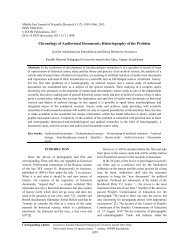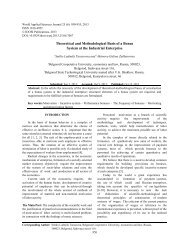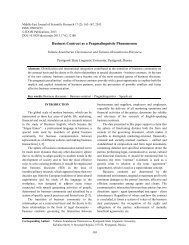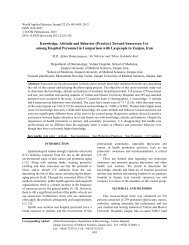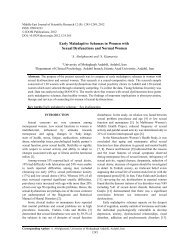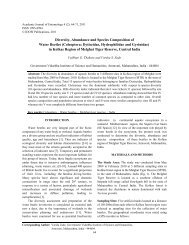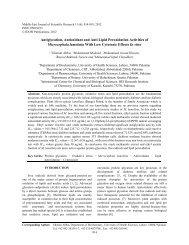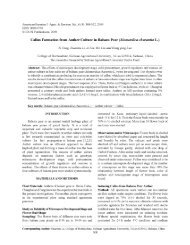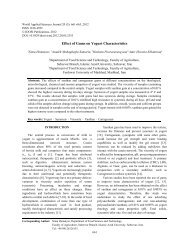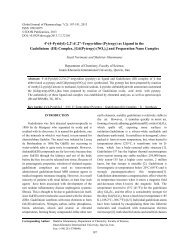Inhibition of Seed Germination By Propyl Gallate, A Free ... - Idosi.org
Inhibition of Seed Germination By Propyl Gallate, A Free ... - Idosi.org
Inhibition of Seed Germination By Propyl Gallate, A Free ... - Idosi.org
You also want an ePaper? Increase the reach of your titles
YUMPU automatically turns print PDFs into web optimized ePapers that Google loves.
World Journal <strong>of</strong> Agricultural Sciences 4 (S): 914-921, 2008<br />
ISSN 1817-3047<br />
© IDOSI Publications, 2008<br />
<strong>Inhibition</strong> <strong>of</strong> <strong>Seed</strong> <strong>Germination</strong> <strong>By</strong> <strong>Propyl</strong> <strong>Gallate</strong>, A <strong>Free</strong> Radical Scavenger and<br />
Recovery <strong>of</strong> <strong>Germination</strong> <strong>By</strong> Hydrogen Peroxide and Ethylene in Vigna Radiata<br />
Abira Chaudhuri and Rup Kumar Kar<br />
Plant Physiology and Biochemistry Laboratory, Department <strong>of</strong> Botany,<br />
Visva-Bharati University, Santiniketan 731 235, West Bengal, India<br />
Abstract: In the present investigation, effect <strong>of</strong> propyl gallate, a free radical scavenger, was studied on<br />
germination <strong>of</strong> Vigna radiata seeds to verify the role <strong>of</strong> active oxygen species in the regulation <strong>of</strong> seed<br />
germination. <strong>Propyl</strong> gallate inhibited germination and such inhibition was not due to osmotic effect as<br />
verified by the treatment with sucrose solution <strong>of</strong> similar concentrations. Treatments were also effective in<br />
a similar way on water uptake and growth kinetics <strong>of</strong> isolated embryonic axes. Increasing duration <strong>of</strong><br />
pretreatment with propyl gallate also retarded seed germination as well as water uptake and growth <strong>of</strong> axes<br />
proportionately. Conversely, incubation in water followed by treatment with propyl gallate caused<br />
inhibition <strong>of</strong> germination immediately after the transfer. Same pattern was noted in case <strong>of</strong> water uptake<br />
and growth kinetics <strong>of</strong> isolated axes. When the seeds were simultaneously treated with propyl gallate and<br />
hydrogen peroxide, germination was restored to a great extent. Such recovery, though to a far lesser extent,<br />
was also found with ethylene (in the form <strong>of</strong> ethrel) given simultaneously with propyl gallate. No added<br />
effect was found when seeds were treated with both ethylene and hydrogen peroxide together in presence<br />
<strong>of</strong> propyl gallate. However, recovery effect by these combined treatments was not reflected in case <strong>of</strong> water<br />
uptake and growth kinetics <strong>of</strong> isolated axes.<br />
Key words: <strong>Propyl</strong> gallate • Hydrogen peroxide • Ethylene • Active oxygen species • <strong>Seed</strong> germination •<br />
Water uptake • Growth kinetics • Vigna radiata<br />
INTRODUCTION<br />
Active Oxygen Species (AOS) or Reactive Oxygen<br />
Intermediates (ROI) are usually considered as toxic<br />
cellular metabolites, the accumulation <strong>of</strong> which leads to<br />
cell injury and deleterious changes like seed<br />
deterioration [1]. Hydrogen peroxide (HP), a potential<br />
free radical, being produced under cellular conditions or<br />
stress may accumulate leading to deteriorative<br />
processes like Programmed Cell Death (PCD) or<br />
senescence. However, there are now compelling<br />
evidences that HP may act as a signaling molecule in<br />
plants mediating several hormone-regulated processes<br />
[2, 3]. Thus, it is likely that HP may have cross talk<br />
with the signaling pathways <strong>of</strong> plant hormones [3].<br />
Other studies showed that seed germination is<br />
accompanied by HP generation in the embryonic axes<br />
as well as the seed coat [4]. As seed germination<br />
represents a developmental period most sensitive to<br />
pathogen infection, it is argued that HP release in this<br />
stage might play a role in protecting the emerging<br />
embryo against invasion by parasites [4]. However,<br />
promotion <strong>of</strong> germination by exogenous application <strong>of</strong><br />
HP [5] indicates a positive role <strong>of</strong> this AOS in<br />
germination. A recent observation that ETR1, the<br />
ethylene receptor, is involved in HP signaling during<br />
stomatal closure [6] suggesting a possibility <strong>of</strong> similar<br />
cross talk between HP and ethylene (Eth), the latter<br />
being well known promoter <strong>of</strong> seed germination [7].<br />
The present investigation is aimed to justify the<br />
role <strong>of</strong> AOS in seed germination by assessing the effect<br />
<strong>of</strong> propyl gallate (PG), an established potential free<br />
radical scavenger or antioxidant [8] and also to explore<br />
any possible cross talk between HP and Eth in<br />
controlling germination.<br />
MATERIALS AND METHODS<br />
<strong>Seed</strong>s <strong>of</strong> mungbean [Vigna radiata (L.) Wilczek<br />
var B1], collected from Pulses and Oilseeds Research<br />
Station, Behrampur, Murshidabad, West Bengal, India,<br />
were used as experimental material. <strong>Seed</strong>s were first<br />
sterilized in 1% sodium hypochlorite solution followed<br />
by rinsing in distilled water several times and then<br />
incubated in 9 cm petri dishes on Whatman no. 1 filter<br />
paper, moistened with distilled water or test solutions<br />
under controlled temperature (30 o C) and darkness in a<br />
seed germinator.<br />
Corresponding Author: Dr. Rup Kumar Kar, Plant Physiology and Biochemistry Laboratory, Department <strong>of</strong> Botany, Visva-<br />
Bharati University, Santiniketan 731 235, West Bengal, India<br />
914
World J. Agric. Sci., 4 (S): 914-921, 2008<br />
To assess the role <strong>of</strong> AOS in germination seeds<br />
were incubated with PG, a free radical scavenger, <strong>of</strong><br />
different concentrations (1mM, 10mM and 50mM).<br />
A similar experiment was also done with sucrose<br />
(Suc; 10mM and 50mM) to check whether the effect <strong>of</strong><br />
PG was osmotic. At definite intervals germination<br />
percentage <strong>of</strong> seeds was determined. For studying water<br />
uptake and growth kinetics <strong>of</strong> embryonic axes, seeds<br />
were dissected after 6 h <strong>of</strong> incubation in water or<br />
treatment solutions to isolate embryonic axes, which<br />
were again incubated in water or respective treatment<br />
solutions and assessed at definite intervals for water<br />
uptake and growth kinetics. Water uptake kinetics was<br />
measured in terms <strong>of</strong> fresh weight change and growth<br />
kinetics was measured in terms <strong>of</strong> increase in length.<br />
In a different set <strong>of</strong> experiment, seeds were either<br />
treated with PG for different durations (6, 8, 10 and<br />
12h) followed by incubation in water or just reverse, i.e.<br />
incubated in water for different durations (6, 8, 10 and<br />
12h) followed by treatment with PG (10mM). At<br />
intervals (12, 24 and 48h), germination percentage was<br />
noted. Also, under similar conditions changes in fresh<br />
weight and length <strong>of</strong> isolated embryonic axis were<br />
measured at intervals (6, 8, 10, 12 and 30h).<br />
Whether AOS treatment can rescue germination<br />
from inhibition by scavengers was determined by<br />
assessing the effect <strong>of</strong> combined treatment <strong>of</strong> PG<br />
(10mM) and HP (5mM, 10mM, 50mM) on germination<br />
percentage. Effect <strong>of</strong> such combined treatment was also<br />
examined in case <strong>of</strong> water uptake and growth kinetics<br />
<strong>of</strong> isolated axes. To check any possible interaction <strong>of</strong><br />
AOS with Eth, which is also a germination promoter,<br />
seeds were treated simultaneously with PG (10mM) and<br />
Eth, in the form <strong>of</strong> ethrel (10µM, 50 µM, 100µM) and<br />
germination percentage was recorded. Again, the same<br />
experiment was also done for any effect on water<br />
uptake and growth kinetics <strong>of</strong> isolated axes. Lastly,<br />
effect <strong>of</strong> a combination <strong>of</strong> PG (10mM), HP (10mM)<br />
and Eth (50µM) was tested for any effect on<br />
germination percentage.<br />
For germination experiments, three replicates, each<br />
containing 50 seeds, were used, while for determination<br />
<strong>of</strong> fresh weight and lengths <strong>of</strong> axes, ten replicates were<br />
used. Mean values were presented in figures with<br />
standard errors <strong>of</strong> mean values shown as vertical bars.<br />
RESULTS<br />
<strong>Germination</strong> percentage <strong>of</strong> seeds <strong>of</strong> V. radiata<br />
incubated at different concentrations (1mM, 10mM,<br />
50mM) <strong>of</strong> PG has been shown in Fig. 1. It was<br />
observed that incubation with higher concentrations <strong>of</strong><br />
PG (10mM, 50mM) caused total inhibition <strong>of</strong><br />
germination even up to 48 h <strong>of</strong> incubation. However,<br />
Fig. 1:<br />
Fig. 2:<br />
100<br />
80<br />
60<br />
40<br />
20<br />
0<br />
100<br />
6 7 8 9 10 11 12 24 48<br />
Hours <strong>of</strong> incubation<br />
CON<br />
1mM PG<br />
10mM PG<br />
50mM PG<br />
Effect <strong>of</strong> propyl gallate (1, 10 and 50 mM) on<br />
germination percentage <strong>of</strong> Vigna radiata seeds.<br />
SE indicated as vertical bars<br />
80<br />
60<br />
40<br />
20<br />
0<br />
CON<br />
10mM PG<br />
50mM PG<br />
10mM Suc<br />
50mM Suc<br />
6 7 8 9 10 11 12 24 48<br />
Hours <strong>of</strong> incubation<br />
Comparative effect <strong>of</strong> propyl gallate (10 and<br />
50 mM) and sucrose (10 and 50 mM) on<br />
germination percentage <strong>of</strong> V. radiata seeds. SE<br />
indicated as vertical bars<br />
1mM PG showed rather a promotion <strong>of</strong> germination as<br />
compared to control at least during the early hours (up<br />
to 9 h). To crosscheck whether inhibitory effect <strong>of</strong> high<br />
concentration PG was osmotic or not, treatment was<br />
also done with the same concentrations (10mM, 50mM)<br />
<strong>of</strong> Suc solution as an osmoticum and monitored for<br />
germination (Fig. 2). Although the germination<br />
percentage in Suc solutions was initially somewhat<br />
lower than in water, later the percentage reached to<br />
100%. Studies on the comparative changes in fresh<br />
915
World J. Agric. Sci., 4 (S): 914-921, 2008<br />
5<br />
4<br />
CON<br />
10mM PG<br />
10mM Suc<br />
10<br />
8<br />
CON<br />
10mM PG<br />
10mM Suc<br />
3<br />
6<br />
2<br />
4<br />
1<br />
2<br />
0<br />
6 8 10 30<br />
0<br />
6 8 10 30<br />
Hours <strong>of</strong> incubation<br />
Hours <strong>of</strong> incubation<br />
A<br />
B<br />
Fig. 3:<br />
Comparative effect <strong>of</strong> propyl gallate (10 mM) and sucrose (10 mM) on water uptake and growth kinetics <strong>of</strong><br />
isolated embryonic axes <strong>of</strong> V.radiata seeds. SE indicated as vertical bars<br />
100<br />
80<br />
60<br />
40<br />
CON<br />
PG (cont)<br />
PG(6 h)<br />
PG(8 h)<br />
PG(10 h)<br />
4<br />
3<br />
2<br />
1<br />
CON<br />
PG (cont)<br />
PG(6 h)<br />
PG(8 h)<br />
PG(10 h)<br />
PG(12 h)<br />
20<br />
0<br />
12 24 48<br />
Hours <strong>of</strong> incubation<br />
PG(12 h)<br />
0<br />
6 8 10 12 30<br />
Hours <strong>of</strong> incubation<br />
A<br />
Fig. 4:<br />
Effect <strong>of</strong> different durations <strong>of</strong> pretreatment<br />
with propyl gallate (10 mM) followed by<br />
incubation in water on germination<br />
percentage <strong>of</strong> V. radiata seeds. SE indicated<br />
as vertical bars<br />
weight and length <strong>of</strong> isolated axis in PG (10mM) and<br />
Suc (10mM) (Fig. 3) showed that both fresh weight<br />
(Fig. 3A) and length <strong>of</strong> axis (Fig. 3B) was increased<br />
gradually in water as well as in Suc solution, while<br />
treatment with PG inhibited such increases.<br />
When the seeds were pretreated with PG (10mM)<br />
for 6, 8, 10 and 12h followed by transfer to distilled<br />
water (Fig. 4), at 12h germination percentage reached<br />
100% in control while the percentage was lower in<br />
seeds that received PG treatment, the value being<br />
proportionate to the duration <strong>of</strong> PG treatment. After<br />
24h, percentage reached almost to the level <strong>of</strong> control<br />
in seeds incubated in PG for 6, 8 and 10h. However, the<br />
916<br />
Fig. 5:<br />
10<br />
8<br />
6<br />
4<br />
2<br />
0<br />
CON<br />
PG (cont)<br />
PG(6 h)<br />
PG(8 h)<br />
PG(10 h)<br />
PG(12 h)<br />
6 8 10 12 30<br />
Hours <strong>of</strong> incubation<br />
B<br />
Effect <strong>of</strong> different durations <strong>of</strong> pretreatment<br />
with propyl gallate (10 mM) followed by<br />
incubation in water on water uptake and growth<br />
kinetics <strong>of</strong> isolated embryonic axes <strong>of</strong> V.<br />
radiata seeds. SE indicated as vertical bars
World J. Agric. Sci., 4 (S): 914-921, 2008<br />
100<br />
80<br />
60<br />
40<br />
20<br />
DW<br />
PG<br />
DW (6h)/PG<br />
DW (8h)/PG<br />
DW (10h)/PG<br />
DW (12h)/PG<br />
0<br />
12 24 48<br />
Hours <strong>of</strong><br />
incubation<br />
Fig. 6:<br />
Effect <strong>of</strong> different durations <strong>of</strong> incubation in water followed by treatment with propyl gallate (10 mM) on<br />
germination percentage <strong>of</strong> V. radiata seeds. SE indicated as vertical bars<br />
4<br />
3<br />
2<br />
DW<br />
PG<br />
DW (6h)/PG<br />
DW (8h)/PG<br />
DW (10h)/PG<br />
DW (12h)/PG<br />
10<br />
8<br />
6<br />
4<br />
DW<br />
PG<br />
DW (6h)/PG<br />
DW (8h)/PG<br />
DW (10h)/PG<br />
DW (12h)/PG<br />
1<br />
2<br />
0<br />
6 8 10 12 30<br />
Hours <strong>of</strong> incubation<br />
0<br />
6 8 10 12 30<br />
Hours <strong>of</strong> incubation<br />
Fig. 7:<br />
A B<br />
Effect <strong>of</strong> different durations <strong>of</strong> incubation in water followed by treatment with propyl gallate (10 mM)<br />
on water uptake and growth kinetics <strong>of</strong> isolated embryonic axes <strong>of</strong> V. radiata seeds. SE indicated as<br />
vertical bars<br />
percentage in case <strong>of</strong> seeds treated in PG for 12h<br />
reached only around 70% even after 48 h. Studies on<br />
changes in fresh weight and length <strong>of</strong> isolated<br />
embryonic axes from seeds received PG treatment for<br />
above-mentioned hours (Fig. 5) showed that fresh<br />
weight <strong>of</strong> axis in control was increased gradually and<br />
axes treated with PG for 6h almost followed the same<br />
trend (Fig. 5A). However, PG treatment for longer<br />
duration (8, 10 and 12h) almost inhibited increase in<br />
fresh weight up to 12h. After 30h fresh weight <strong>of</strong> axes<br />
was increased only in axes treated with PG for 8h, but<br />
not in those treated for 10 or 12h. Similar changes were<br />
noted for length <strong>of</strong> axes also (Fig. 5B).<br />
In another experiment where the seeds were first<br />
incubated in distilled water for 6, 8, 10, 12h followed<br />
by continuous incubation in PG (Fig. 6), germination<br />
percentage <strong>of</strong> the treated seeds at 12h was accordingly<br />
lower than control (100%), shorter the duration <strong>of</strong><br />
incubation in water lower the percentage. <strong>Germination</strong><br />
percentage value during the subsequent period (up to 48<br />
h) <strong>of</strong> incubation in PG was maintained in each case, i.e.<br />
no additional germination occurred once transferred to<br />
PG. Under similar treatment pattern, changes in fresh<br />
weight and length <strong>of</strong> isolated axes were also studied<br />
(Fig. 7). Fresh weight records (Fig. 7A) show that axis<br />
weight was gradually increased in water while<br />
continuous PG treatment arrested this increase. Axes<br />
incubated in water for 6 and 8h followed by PG<br />
incubation also showed a similar inhibition. In case <strong>of</strong><br />
axes incubated in water for 10 and 12h showed an<br />
917
World J. Agric. Sci., 4 (S): 914-921, 2008<br />
100<br />
80<br />
60<br />
CON<br />
PG<br />
PG + HP (5)<br />
PG + HP (10)<br />
PG + HP (50)<br />
40<br />
20<br />
0<br />
6 7 8 9 10 11 12 24 48<br />
Hours <strong>of</strong> incubation<br />
Fig. 8:<br />
Effect <strong>of</strong> combined treatment with propyl gallate (10 mM) and hydrogen peroxide (HP; 5, 10 and 50mM) on<br />
germination percentage <strong>of</strong> V. radiata seeds. SE indicated as vertical bars<br />
4<br />
3<br />
2<br />
CON<br />
PG(10)<br />
PG+HP(5)<br />
PG+HP(10)<br />
PG+HP(50)<br />
8<br />
6<br />
4<br />
CON<br />
PG(10)<br />
PG+HP(5)<br />
PG+HP(10)<br />
PG+HP(50)<br />
1<br />
2<br />
0<br />
6 8 10 12 30<br />
0<br />
6 8 10 12 30<br />
Hours <strong>of</strong> incubation<br />
Hours <strong>of</strong> incubation<br />
A B<br />
Fig. 9:<br />
Effect <strong>of</strong> combined treatment with propyl gallate (10 mM) and hydrogen peroxide (5, 10 and 50 mM)<br />
on water uptake and growth kinetics <strong>of</strong> isolated embryonic axes <strong>of</strong> V. radiata seeds. SE indicated as<br />
vertical bars<br />
increase in fresh weight al least up to 10 or 12h,<br />
respectively and then declined at 30h <strong>of</strong> incubation in<br />
PG. Almost same observation was made for changes in<br />
length <strong>of</strong> axes also under similar treatments (Fig. 7B).<br />
Combined treatment <strong>of</strong> seeds with PG and HP<br />
(5mM, 10mM, 50mM) (Fig. 8) shows that while<br />
treatment with PG alone almost totally inhibited<br />
germination, simultaneous treatment with HP causes<br />
some germination (near 40 % at 24h and around 70% at<br />
the end <strong>of</strong> 48h). All the concentrations <strong>of</strong> HP were<br />
almost effective to the same extent in this regard. Effect<br />
<strong>of</strong> such combined treatment on fresh weight change and<br />
length <strong>of</strong> axes has been depicted in Fig. 9. Both fresh<br />
918<br />
weight (Fig. 9B) and length <strong>of</strong> axes (Fig. 9A) was not<br />
much affected by combination <strong>of</strong> HP and PG as<br />
compared to PG treatment alone, except a marginal<br />
improvement in length <strong>of</strong> axes by HP (5 and 10mM)<br />
only after 30h. In a similar experiment, seeds were<br />
treated with PG in combination with Eth instead <strong>of</strong> HP<br />
and monitored for seed germination. Results (Fig. 10)<br />
revealed that, like HP, Eth also caused some<br />
germination in presence <strong>of</strong> PG, but was less effective<br />
than HP (maximum percentage at the end <strong>of</strong> 48 h was<br />
around 40%). Also, 50 µM concentration <strong>of</strong> Eth was<br />
most effective while 100 µM was least effective. The<br />
same combination was tested for any effect on fresh
World J. Agric. Sci., 4 (S): 914-921, 2008<br />
100<br />
80<br />
60<br />
40<br />
CON<br />
PG (10)<br />
PG + Eth (10)<br />
PG + Eth (50)<br />
PG + Eth (100)<br />
20<br />
0<br />
6 7 8 9 10 11 12 24 48<br />
Hours <strong>of</strong> incubation<br />
Fig. 10: Effect <strong>of</strong> combined treatment with propyl gallate (10 mM) and ethrel (10, 50 and 100 µM) on germination<br />
percentage <strong>of</strong> V. radiata seeds. SE indicated as vertical bars<br />
4<br />
3<br />
2<br />
CON<br />
PG(10)<br />
PG+ETH(10)<br />
PG+ETH(50)<br />
PG+ETH(100)<br />
7<br />
6<br />
5<br />
4<br />
3<br />
CON<br />
PG(10)<br />
PG+ETH(10)<br />
PG+ETH(50)<br />
PG+ETH(100)<br />
1<br />
2<br />
1<br />
0<br />
6 8 10 12 30<br />
Hours <strong>of</strong> incubation<br />
0<br />
6 8 10 12 30<br />
Hours <strong>of</strong> incubation<br />
A B<br />
Fig. 11: Effect <strong>of</strong> combined treatment with propyl gallate (10 mM) and ethrel (10, 50 and 100 µM) on water uptake<br />
and growth kinetics <strong>of</strong> isolated embryonic axes <strong>of</strong> V. radiata seeds. SE indicated as vertical bars<br />
weight and length <strong>of</strong> isolated axe s (Fig. 11). This shows<br />
again that combined treatment with PG and Eth did not<br />
have any effect over PG treatment alone on both fresh<br />
weight (Fig. 11A) and length <strong>of</strong> axes (Fig. 11B). Fig 12<br />
reveals the effect <strong>of</strong> triple combination (PG+HP+Eth)<br />
along with all double combinations (PG+HP, PG+Eth,<br />
Eth+HP) and control. While the combination <strong>of</strong> Eth and<br />
HP showed a rate <strong>of</strong> germination quite similar to<br />
control set, triple combination showed germination rate<br />
same as PG+Eth until 24h beyond which the percentage<br />
improved somewhat at 48h reaching almost to the level<br />
<strong>of</strong> what was achieved by PG+HP.<br />
DISCUSSION<br />
Several lines <strong>of</strong> evidence suggest that AOS<br />
including HP alleviates seed dormancy [9]. But in<br />
non-dormant seeds exogenous application <strong>of</strong> HP may<br />
have no effect, as was found in case <strong>of</strong> V. radiata seeds<br />
(data not shown). This may be due to generation <strong>of</strong><br />
adequate level <strong>of</strong> HP endogenously, as reported in a<br />
number <strong>of</strong> cases [10, 11] and the presence <strong>of</strong> HP has<br />
been correlated with germination in these cases. In a<br />
reverse approach, here seeds <strong>of</strong> V. radiata were treated<br />
with PG, a free radical scavenger [8], to verify the role<br />
919
100<br />
80<br />
60<br />
40<br />
20<br />
0<br />
7 8 9 10 11 12 24 48<br />
Hours <strong>of</strong> incubation<br />
World J. Agric. Sci., 4 (S): 914-921, 2008<br />
CON<br />
PG+HP<br />
PG+ETH<br />
ETH+HP<br />
PG+HP+ETH<br />
Fig. 12: Effect <strong>of</strong> different combinations <strong>of</strong> propyl<br />
gallate (10 mM), hydrogen peroxide (10m M)<br />
and ethrel (50 µM) on germination percentage<br />
<strong>of</strong> V. radiata seeds. SE indicated as vertical<br />
bars<br />
<strong>of</strong> free radicals in the process <strong>of</strong> seed germination.<br />
Clearly, PG treatment inhibited germination (Fig. 1)<br />
and such inhibition was not due to osmotic stress, as<br />
similar concentrations <strong>of</strong> Suc (used as osmoticum)<br />
could not inhibit germination (Fig. 2). This was further<br />
supported by the observed water uptake and growth<br />
kinetics <strong>of</strong> isolated axes under the same treatments (Fig.<br />
3), where again PG, but not Suc, inhibited both water<br />
uptake and growth <strong>of</strong> axes. Ogawa and Iwabuchi [5],<br />
showed a decline in seed germination rate by PG<br />
treatment. It is suggested that a temporal oxidized state<br />
<strong>of</strong> the seed embryo that is induced by HP might initiate<br />
germination and that antioxidant germination<br />
inhibitor(s) might prevent the induction <strong>of</strong> the oxidized<br />
state in seeds. However, being an antioxidant, PG was<br />
also reported to inhibit alternative respiratory pathway<br />
[12] and Eth biosynthesis [13]. Indeed, Gallardo et al.<br />
[14] and Nun et al. [15] demonstrated an inhibition <strong>of</strong><br />
seed germination using PG and they ascribed such<br />
inhibition as due to inhibition <strong>of</strong> Eth biosynthesis and<br />
alternative oxidase, respectively. Thus, the effect <strong>of</strong> PG<br />
in these directions also cannot be ruled out at this<br />
moment, though AOS may act directly by inducing cell<br />
wall loosening process underlying cell expansion<br />
during radicle elongation [1].<br />
In subsequent experiments on pretreatment with<br />
PG revealed that increasing duration <strong>of</strong> PG treatment<br />
inhibit germination quantitatively (Fig. 4). Similar<br />
effect was also noted in case <strong>of</strong> water uptake and<br />
growth kinetics <strong>of</strong> isolated embryonic axes (Fig. 5).<br />
Practically, effect <strong>of</strong> a treatment on germination is<br />
reflected on water uptake and growth by isolated axes,<br />
as we have shown earlier while studying the effect<br />
<strong>of</strong> cycloheximide and chilling temperature on seed<br />
germination and water uptake and growth kinetics <strong>of</strong><br />
isolated axes <strong>of</strong> V. radiata [16]. Thus both water uptake<br />
and growth <strong>of</strong> axes remained inhibited through 30 h <strong>of</strong><br />
incubation when the duration <strong>of</strong> pretreatment was<br />
prolonged for 10h or more. On the reverse, in case <strong>of</strong><br />
pretreatment with water followed by PG treatment,<br />
increase <strong>of</strong> germination percentage (Fig. 6) and water<br />
uptake and growth by axes (Fig. 7) stopped as soon as<br />
they were transferred to PG. This suggests that a<br />
continuous supply <strong>of</strong> AOS is needed to initiate<br />
germination as well as water uptake and elongation <strong>of</strong><br />
radicle. When PG treatment was supplemented with HP<br />
(Fig. 8), germination was recovered to a great extent<br />
(up to 70% after 48h) indicating that the presence <strong>of</strong> HP<br />
helps in germination process and PG inhibits the<br />
process by scavenging HP. However, such recovery<br />
was not found in case <strong>of</strong> water uptake and growth<br />
kinetics <strong>of</strong> isolated axes by combined treatment with<br />
PG and HP (Fig. 9).<br />
With a possibility <strong>of</strong> interplay <strong>of</strong> HP and plant<br />
hormones like Eth, as demonstrated in several<br />
instances [1-3] and involvement <strong>of</strong> Eth in seed<br />
dormancy and germination [17], Eth was tested for<br />
possible recovery <strong>of</strong> germination <strong>of</strong> V. radiata seeds<br />
from PG inhibition (Fig. 10). Recovery was partial,<br />
though less effective than HP, indicating a possible<br />
cross talk between HP and Eth. However, again this<br />
was not reflected in case <strong>of</strong> water uptake and growth<br />
studies with isolated axes (Fig. 11). There are reports<br />
that HP may act upstream <strong>of</strong> Eth-related plant responses<br />
by activating ACC oxidase, thus enhancing Eth<br />
production [18] or conversely, Eth might stimulate<br />
AOS production [19]. Besides, Desikan et al. [20] have<br />
shown that Eth response transcription factors are up<br />
regulated by HP. Recently, Desikan et al. [6]<br />
showed that ethylene receptor, ETR1 mediates HP<br />
signaling in stomatal guard cells in Arabidopsis<br />
thaliana. Based on these findings it may be speculated<br />
that, in the present study, Eth and HP acted<br />
independently on a common element <strong>of</strong> downstream<br />
signaling leading to germination, since Eth can<br />
compensate partially the absence <strong>of</strong> AOS (in presence<br />
<strong>of</strong> PG) and further addition <strong>of</strong> HP could improve,<br />
though marginally, the recovery <strong>of</strong> germination<br />
percentage by Eth in presence <strong>of</strong> PG in the later stage<br />
(Fig. 12).<br />
920<br />
REFERENCES<br />
1. Bailly, C., 2004. Active oxygen species and<br />
antioxidants in seed biology. <strong>Seed</strong> Science<br />
Research, 14: 93-107.<br />
2. Vranová, E., D. Inzé and F. Van Breusegem, 2002.<br />
Signal transduction during oxidative stress. Journal<br />
<strong>of</strong> Experimental Botany, 53 (372): 1227-1236.
World J. Agric. Sci., 4 (S): 914-921, 2008<br />
3. Kwak, J.M., V. Nguyen and J.I. Schroeder, 2006.<br />
The role <strong>of</strong> reactive oxygen species in hormonal<br />
responses. Plant Physiology, 141: 323-329.<br />
4. Schopfer, P., C. Plachy and G. Frahry, 2001.<br />
Release <strong>of</strong> reactive oxygen intermediates (super<br />
oxide radicals, hydrogen peroxide and hydroxyl<br />
radicals) and peroxidase in germinating radish<br />
seeds controlled by light, gibberellin and abscisic<br />
acid. Plant Physiology, 125: 1591-1602.<br />
5. Ogawa, K. and M. Iwabuchi, 2001. A mechanism<br />
for promoting the germination <strong>of</strong> Zinnia elegans<br />
seeds by hydrogen peroxide. Plant Cell Physiology,<br />
42 (3): 286-291.<br />
6. Desikan, R., J.T Hancock, J. Bright, J. Harrison, I.<br />
Weir, R. Hooley and S.J. Neill, 2005. A role for<br />
ETR1 in hydrogen peroxide signaling in stomatal<br />
guard cells. Plant Physiology, 137: 831-834.<br />
7. Kucera, B., M.A. Cohn and G. Leubner-Metzger,<br />
2005. Plant hormone interactions during seed<br />
dormancy release and germination. <strong>Seed</strong> Science<br />
Research, 15: 281-307.<br />
8. Nagata, T., S. Todoriki and S. Kikuchi, 2004.<br />
Radial expansion root cells and elongation <strong>of</strong> root<br />
hairs <strong>of</strong> Arabidopsis thaliana induced by massive<br />
doses <strong>of</strong> gamma irradiation. Plant Cell Physiology,<br />
45 (11): 1557-1565.<br />
9. Bogatek, R., H. Gawronska and K. Oracz, 2003.<br />
Involvement <strong>of</strong> oxidative stress and ABA in CNmediated<br />
elimination <strong>of</strong> embryonic dormancy in<br />
apple. In The Biology <strong>of</strong> <strong>Seed</strong>s: Recent Research<br />
Advances. Nicolas, G., K.J. Bradford, D. Côme<br />
and H.W. Pritchard (Eds.). CABI Publishing,<br />
Wallingford, pp: 211-216.<br />
10. Bailly, C., R. Bogatek-Leszczynska, D. Côme and<br />
F. Corbineau, 2002. Changes in activities <strong>of</strong><br />
antioxidant enzymes and lipoxygenase during<br />
growth <strong>of</strong> sunflower seedlings from seeds <strong>of</strong><br />
different vigour. <strong>Seed</strong> Science Research, 12: 47-55.<br />
11. Morohashi, Y., 2002. Peroxidase activity develops<br />
in the micropylar endosperm <strong>of</strong> tomato seeds prior<br />
to radicle protrusion. Journal <strong>of</strong> Experimental<br />
Botany, 53 (374): 1643-1650.<br />
12. Siedow, J.N. and M.E. Girvin, 1980. Alternative<br />
respiratory pathway. Its role in seed respiration and<br />
its inhibition by propyl gallate. Plant Physiology,<br />
65: 669-674.<br />
13. Mor, Y., H. Spiegelstein and A.H. Halevy, 1983.<br />
<strong>Inhibition</strong> <strong>of</strong> ethylene biosynthesis in carnation<br />
petals by cytokinin. Plant Physiology, 71: 541-546.<br />
14. Gallardo, M., P. Munoz De Rueda, A. Matilla and<br />
I.M. Sanchez-Calle, 1994. The relationship<br />
between ethylene production and germination<br />
<strong>of</strong> Cicer arietinum seeds. Biologia Plantarum,<br />
36 (2): 201-207.<br />
15. Nun, N.B., D. Plakhine, D.M Joel and A.M.<br />
Mayer, 2003. Changes in the activity <strong>of</strong> the<br />
alternative oxidase in Orobanche seeds during<br />
conditioning and their possible physiological<br />
function. Phytochemistry, 64 (1): 235-241.<br />
16. Kar, R.K. and R. Chakraborty, 2003. Effect <strong>of</strong><br />
cycloheximide and chilling temperature on the<br />
control <strong>of</strong> seed germination in mungbean.<br />
Indian Journal <strong>of</strong> Plant Physiology, Special<br />
Issue, pp: 205-209.<br />
17. Corbineau, F. and D. Côme, 1995. Control <strong>of</strong> seed<br />
germination and dormancy by the gaseous<br />
environment. In <strong>Seed</strong> Development and<br />
<strong>Germination</strong>. Kigel, J. and G. Galili. Marcel<br />
Dekker (Eds.). New York, pp: 397-427.<br />
18. Chamnongpol, S., H. Willekens, W. Moeder, C.<br />
Langebartels, H. Sandermann, M. Van Montagu,<br />
D. Inzé and W. Van Camp, 1998. Defense<br />
activation and enhanced pathogen tolerance<br />
induced by H 2 O 2 in transgenic tobacco. In the<br />
Proceedings <strong>of</strong> the National Academy <strong>of</strong> Sciences,<br />
USA, 95, pp: 5818-5823.<br />
19. Overmyer, K., M. Brosche and J. Kangasjarvi,<br />
2003. Reactive oxygen species and hormonal<br />
control <strong>of</strong> cell death. Trends in Plant Science,<br />
8: 335-342.<br />
20. Desikan, R., S.A.H. Mackerness, J.T. Hancock and<br />
S.J. Neill, 2001. Regulation <strong>of</strong> the Arabidopsis<br />
transcriptome by oxidative stress. Plant<br />
Physiology, 127: 159-172.<br />
921



